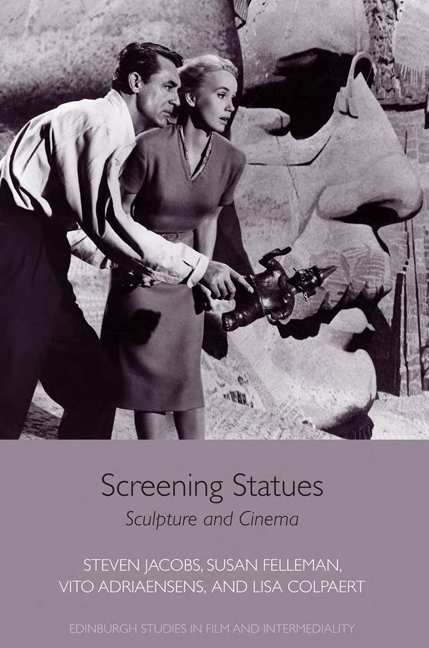Book contents
- Frontmatter
- Contents
- List of Figures
- Acknowledgements
- Introduction: The Marble Camera
- PART I
- 1 The Sculptor's Dream: Living Statues in Early Cinema
- 2 The Mystery … The Blood … The Age of Gold: Sculpture in Surrealist and Surreal Cinema
- 3 Carving Cameras on Thorvaldsen and Rodin: Mid-Twentieth- Century Documentaries on Sculpture
- 4 Anatomy of an Ovidian Cinema: Mysteries of the Wax Museum
- 5 The Night of the Human Body: Statues and Fantasy in Postwar American Cinema
- 6 From Pompeii to Marienbad: Classical Sculptures in Postwar European Modernist Cinema
- 7 Of Swords, Sandals, and Statues: The Myth of the Living Statue
- 8 Coda: Returning the Favor (A Short History of Film Becoming Sculpture)
- PART II
- Bibliography
- About the Authors
- Index
8 - Coda: Returning the Favor (A Short History of Film Becoming Sculpture)
from PART I
Published online by Cambridge University Press: 23 June 2018
- Frontmatter
- Contents
- List of Figures
- Acknowledgements
- Introduction: The Marble Camera
- PART I
- 1 The Sculptor's Dream: Living Statues in Early Cinema
- 2 The Mystery … The Blood … The Age of Gold: Sculpture in Surrealist and Surreal Cinema
- 3 Carving Cameras on Thorvaldsen and Rodin: Mid-Twentieth- Century Documentaries on Sculpture
- 4 Anatomy of an Ovidian Cinema: Mysteries of the Wax Museum
- 5 The Night of the Human Body: Statues and Fantasy in Postwar American Cinema
- 6 From Pompeii to Marienbad: Classical Sculptures in Postwar European Modernist Cinema
- 7 Of Swords, Sandals, and Statues: The Myth of the Living Statue
- 8 Coda: Returning the Favor (A Short History of Film Becoming Sculpture)
- PART II
- Bibliography
- About the Authors
- Index
Summary
Susan Felleman
This book has focused on the many manifestations and aspects of sculpture in cinema. We have demonstrated that sculpture – especially figural sculpture – engages the living figure in a range of intermedial ways in film, heightening tensions around motion and stasis, the animate and inanimate, life and death, presence and absence, as well as embodying narrative themes. This is in theory as true for sculptures that play a small role, as props or minor plot devices, as for those that are central actors. In Rear Window, for instance, the abstract sculpture on which a neighbor of Jeff's is shown working is seen briefly and intermittently but it is overdetermined. The lady artist is a Greenwich Village cliché and she is ridiculed along predictably sexist lines. Along with the dancer and the composer who are among Jeff's other neighbors, she exemplifies the bohemian milieu in ways both realist and comical. The sculpture itself, as with the ballerina referred to as “Miss Torso,” is suggestive of – even almost a substitute for – the dismembered body of Mrs. Thorwald that cannot be shown: only imagined. Although it suggests an abstracted partial figure or bust, it consists primarily of a phallic form and a yonic one (protuberance and void), inserting into the scene psychosexual symbolism that underscores Hitchcock's voyeuristic and perverse themes.
If sculpture can contribute intermedial meaning and complexity to a film, is not the opposite equally true? While cinema often incorporated sculpture from early in film history, sculpture was slow to return the favor. In the 1920s and 1930s, sculpture began to move, with mobile and kinetic innovations such as the rotating Lipchitz sculpture discussed in Chapter 2, Alexander Calder's mobiles, László Moholy-Nagy's Light-Space-Modulator (discussed in the Introduction), and some constructivist works, incorporating move¬ment and therefore change in time, dynamizing a previously static practice. Numerous artists, among them George Rickey, Jean Tinguely, Harry Bertoia, and artist-filmmakers Robert Breer and Len Lye, enlarged and energized the field of kinetic sculpture in the 1950s. materialist film, that sustained, varied and truly intermedial experimentation began to produce a critical mass of work incorporating the materials and methods of film itself with sculpture.
- Type
- Chapter
- Information
- Screening StatuesSculpture and Cinema, pp. 156 - 168Publisher: Edinburgh University PressPrint publication year: 2017



